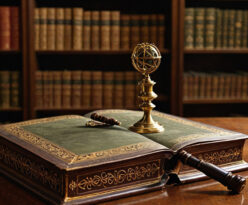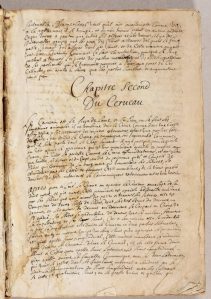
18th-century French manuscript on human anatomy and surgical practice, anonymous, France, 18th century, contemporary leather binding, black/brown ink on rag linen paper, approx. size 26 x 19 x 6.5 cm, 572 pages, titled Traité d’hygiène (Anatomical Observations & Treatise on Surgery), elegantly handwritten in black or brown ink by different hands, Part I: anatomical treatise on human anatomy (pp. 3-188) with sections on birds (pp. 184-188), fish (pp. 177-179), and the digestive system of animals (pp. 180-183), Part II: extensive treatise on surgery (pp. 193-572), bound in its original contemporary binding. Missing pages 1&2, 479, 480, 481 & 482, possibly missing one or two pages at rear.
A similar manuscript with an exactly worded chapters, Matiere Medicale, was sold by a French bookseller, the first blank bearing an inscription mentioning a Mr. Chyrac.
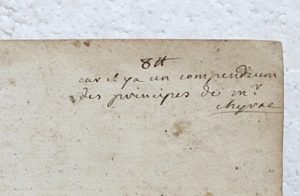
This is probably Pierre Chirac (1657–1732) who taught at the Faculty of Medicine of Montpellier (Faculté de Médecine de Montpellier), one of the oldest and most prestigious medical schools in Europe. As a professor there, he specialized in anatomy and surgery, gaining a strong reputation for his clinical and practical approach to medicine. His work at Montpellier helped shape the next generation of French physicians before he transitioned to royal service and medical administration in Paris.
An inscription on the first paste down may shed the iden
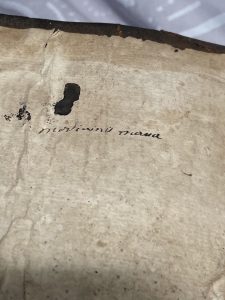
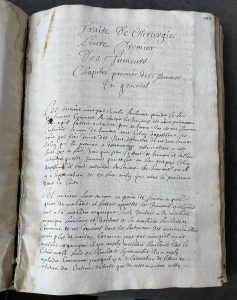
The manuscript features long chapter on Female and Male reproductive organs where the functions are described including the pleasures experienced from coital stimulations.
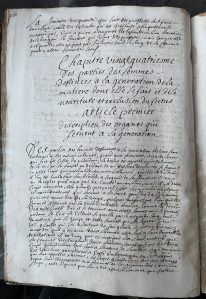
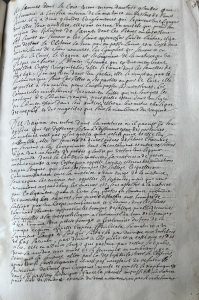
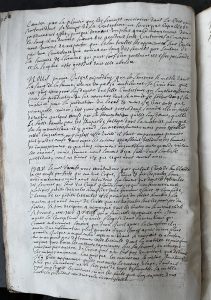
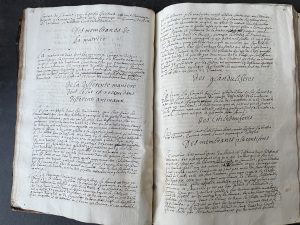
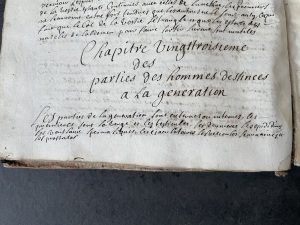
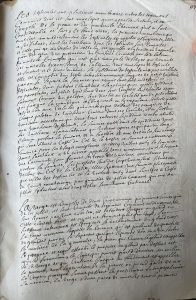 Table of contents for the anatomy part of the manuscript
Table of contents for the anatomy part of the manuscript
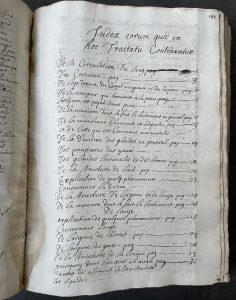
De la Circulation du Sang (On blood circulation) – page 1
Du Cerveau (On the brain) – page 3
De l’épiderme, du Corps muqueux et de la peau (On the epidermis, mucous body and skin) – page 11
De la rougeur qui survient à la peau (On redness that occurs on the skin) – page 13
Lorsqu’on est piqué d’une puce (When bitten by a flea)
De la manière dont se fait le sentiment en general (On how sensation occurs in general) – page 13
De la membrane Charneuese et adipeuse (On the fleshy and adipose membrane) – page 13
Et de Celle qui est Commune aux muscles (And that which is common to muscles)
De la Division des glandes en general (On the division of glands in general) – page 19
Des paupières des yeux (On the eyelids)
Des glandes lacrímales et des larmes (On tear glands and tears) – page 18
De la Structure de l’oeil (On the structure of the eye) – page 20
Explication de quelq. phénomènes Concernant la Vision (Explanation of some phenomena concerning vision) – page 22
De la structure De l’organe et de l’ouye (On the structure of the organ of hearing) – page 24
De la maniere dont se fait le sentiment de l’ouye (On how the sensation of hearing occurs) – page 25
Explication de quelques phénomènes Concernant l’ouye (Explanation of some phenomena concerning hearing) – page 18
De l’organe de l’odorat (On the organ of smell) – page 27
De l’organe du goust (On the organ of taste) – page 28
De la Structure de la langue (On the structure of the tongue) – page 29
Pourquoy dans l’origine on avale (Why in the beginning one swallows) – page 30
tantost les aliments solides tantost les liquides (sometimes solid foods, sometimes liquids)
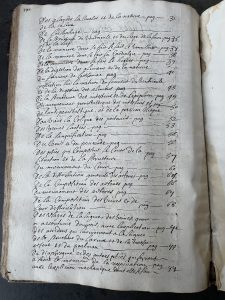
Des glandes salivales et de la nature de la Salive (On salivary glands and the nature of saliva) – page 31
De l’œsophage (On the esophagus) – page 32
De la structure du ventricule et du siège de la faim (On the structure of the ventricle/stomach and the seat of hunger) – page 35
De la soif (On thirst)
De la manière dont se fait le fait l’vomissement (On how vomiting occurs) – page 37
De la manière dont se fait la Cardialgie (On how heartburn occurs) – page 38
De la manière dont se fait le hoquet (On how hiccups occur) – page 39
De la digestion des aliments et de la nature du ferment de l’estomac (On digestion of food and the nature of stomach enzymes) – page 41
Réflexion sur la nature du ferment du ventricule et de la digestion des aliments (Reflection on the nature of stomach enzymes and food digestion) – page 43
De la structure des intestins et de l’épiploon (On the structure of intestines and omentum) – page 49
Du mouvement péristaltique des intestins et de l’antipéristaltique, et de la passion iliaque (On peristaltic movement of intestines, antiperistaltic, and iliac passion) – page 50
D’où vient la Colique des poitevins (On the origin of the colic of Poitou) – page 52
Des veines lactées (On the lacteal veins) – page 53
De la sanguification (On blood formation) – page 55
Du Cœur et du péricarde (On the heart and pericardium) – page 56
Des ptits qui Composent le Cœur de la situation et de la structure (On the parts that compose the heart, its situation and structure) – page 57
Du mouvement du Cœur (On the movement of the heart) – page 60
De la distribution générale des artères (On the general distribution of arteries) – page 64
De la Composition des artères (On the composition of arteries) – page 65
Du mouvement des artères (On the movement of arteries) – page 67
De la Composition des veines et de leur distribution (On the composition of veins and their distribution) – page 68
Des usages de la Saignée des veines qu’on a accoutumé d’ouvrir, avec l’explication (On the uses of bloodletting of veins that are customarily opened, with explanation) – page 71
Des accidents qui surviennent à la Saignée (On accidents that occur during bloodletting)
De la structure du Larynx et de la trachée artère et du poumon (On the structure of the larynx, trachea and lung) – page 77
Du diaphragme et des autres parties qui servent à faire le mouvement de la respiration avec l’explication méchanique d’icelle (On the diaphragm and other parts that serve to make the movement of respiration with mechanical explanation thereof) – page 79
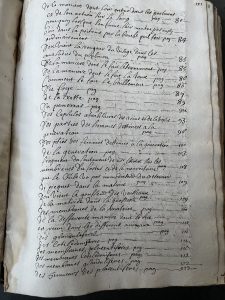 This image shows page 191 of the same handwritten manuscript, continuing the index from the previous pages. The entries with their corresponding page numbers are:
This image shows page 191 of the same handwritten manuscript, continuing the index from the previous pages. The entries with their corresponding page numbers are:
De la manière dont l’air entre dans les poumons et de son action sur le sang (On how air enters the lungs and its action on blood) – page 80
Pourquoy lorsque l’on fume l’air n’entre pas aussi bien dans la poitrine par la bouche qu’il fait ordinairement (Why when smoking, air does not enter the chest through the mouth as it normally does) – page 84
D’où vient la rougeur du visage dans les maladies du poumon (On the origin of facial redness in lung diseases) – page 83
De la manière dont se fait l’éternuement (On how sneezing occurs) – page 85
De la manière dont se fait la toux (On how coughing occurs) – page 86
Comment se fait le bâillement (How yawning occurs) – page 86
Du foye (On the liver) – page 87
De la ratte (On the spleen) – page 89
Du pancreas (On the pancreas) – page 91
Des Capsules atrabilaires des reins et de vessie (On the adrenal capsules of the kidneys and bladder) – page 93
Des parties des hommes destinées à la génération (On male reproductive organs) – page 96
Des parties des femmes destinées à la génération (On female reproductive organs) – page 100
De la génération (On reproduction) – page 103
Fragment du soutènement de mes thèses sur les membranes du foetus et de la nourriture (Fragment of my thesis defense on fetal membranes and nutrition) – page 108
Que le Chile va pas immediatemt du receptacul de pequet dans la matrice (That chyle does not go immediately from the receptacle of Pecquet to the uterus) – page 109
D’où vient le gonflement des vaisseaux de la matrice dans la grossesse (On the origin of swelling of uterine vessels during pregnancy) – page 109
Des membranes de la matrice (On the membranes of the uterus) – page 110
De la différente manière dont le fœtus est nourri dans les différents animaux (On the different ways the fetus is nourished in different animals) – page 110
Des glandes différentes (On different glands) – page 112
Des Cotiledoniferes (On cotyledoniferous [structures]) – page 112
Des membranes placentiferes (On placentiferous membranes) – page 112
Des membranes Cotiledoniferes (On cotyledoniferous membranes) – page 112
Des membranes glanduleuses (On glandular membranes) – page 112
Des humeurs des placentiferes (On fluids of placentiferous [structures]) – page 112
Des humeurs des Cotiledoniferes (On fluids of cotyledoniferous structures) – page 114
Des humeurs des glanduleuses (On fluids of glandular structures) – page 114
Des vaisseaux ombilicaux (On umbilical vessels) – page 114
Des anastomoses des vaisseaux dans le foetus et de la manière dont le sang y circule (On anastomoses of vessels in the fetus and how blood circulates there) – page 115
De la manière dont se fait l’exclusion du foetus et de la matrice (On how the exclusion of the fetus from the uterus occurs) – page 118
Des vaisseaux lymphatiques et de la lymphe (On lymphatic vessels and lymph) – page 120
De la nature des os en général (On the nature of bones in general) – page 123
Des unions et des articulations des os (On unions and articulations of bones) – page 124
Des os de la tête (On bones of the head) – page 126
Des os du crane (On bones of the skull) – page 131
Des os des extremités (On bones of the extremities) – page 133
The index continues with entries about muscles, nerves, and various anatomical structures, eventually concluding with:
Idée générale de la structure des petits intestins des oiseaux (General idea of the structure of small intestines of birds) – page 184

The text also relates to experiments on sensations, where différents mutilations were performed on dogs. Several paragraphs describe the experiments in detail.
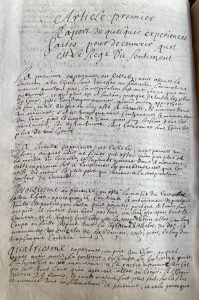
The works also delves into animal anatomies with extensive chapters on birds, fish and ruminants.
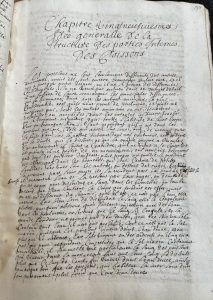
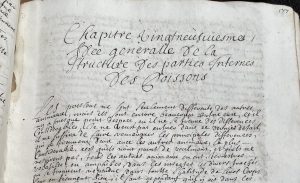
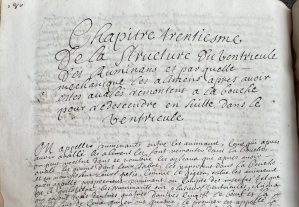
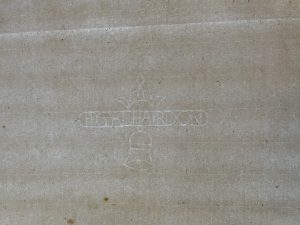
Watermark from a blank page separating the text.
